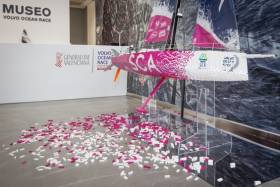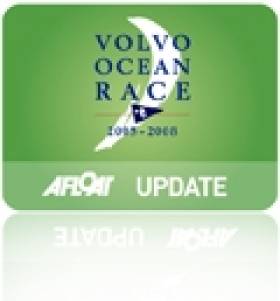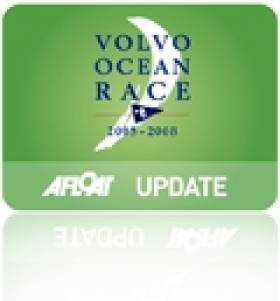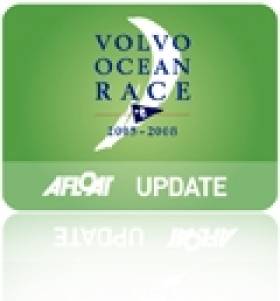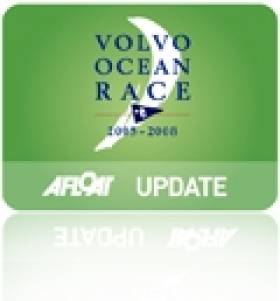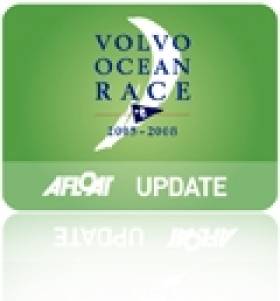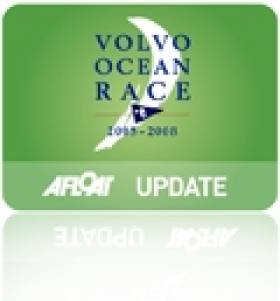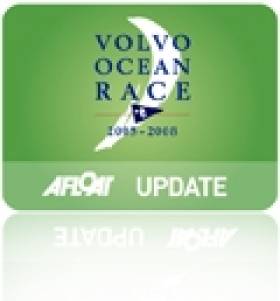Displaying items by tag: Team SCA
#VOR - A fully functioning model of Team SCA's Volvo Ocean 65 made entirely of 100,000 Lego pieces is on exhibition in the Volvo Ocean Race museum from this week.
The launch of the Lego replica of the boat that safely delivered the all-female crew of Team SCA around the world in the 2014-15 race coincided with International Women’s Day, Tuesday 8 March.
The model was donated by SCA, the Swedish global hygiene company, which sponsored skipper Sam Davies’s crew in the nine-month marathon race.
It was displayed at each of the 11 ports that hosted the 12th edition before being transported to its new permanent home in the Alicante-based Volvo Ocean Race museum.
“The boat is in the best place possible. After a long journey around the world, it has returned home,” said Anders Gaasedal, one of the men who constructed it.
The Dane, who works for Lego, embarked in 2013 on the challenge of making the Volvo Ocean 65 replica together with his Swedish friend Johan Sahlström, an engineer for Volvo Trucks. They achieved their target after 1,200 hours of work.
“At the start of the regatta, we dreamed of bringing the boat back to Alicante. This has been an adventure for us and for Team SCA. It’s marvellous that the boat is being exhibited in the museum. The more people who can enjoy it the better,” added Sahlström.
What started as a diverting challenge for two friends developed into a complete engineering and logistic project, replicating in miniature the dimensions of the boat (2.32 metres in length, 3.03 metres mast height, 0.56 metres width of the hull). It has a functioning, scaled-down keel (+/- 40 degrees with five degrees of tilt from its axis).
“Everything works, the pieces are not stuck together. The most difficult thing was making everything curve using pieces that are basically rectangular. This is most beautiful model that I have ever made,” said Sahlström.
“Our boat from the distance looks like a real model, you can´t see it´s made of LEGO® bricks, and then, when you come closer, it´s a great surprise. Everything has curves, it´s been built in 3D, the bricks have been put together from the top, the side and the bottom, and all is shiny. Children always build from the bottom to the top.”
The Volvo Ocean Race museum, which offers free entrance, welcomed more than 50,000 visitors in 2015 and is the only one in the world dedicated to almost 43 years of history of the round-the-world race.
Alicante, headquarters of the Volvo Ocean Race organisation since 2010, was the departure port in the last three editions of the race and will be so again in the next event starting in 2017.
SCA has a long record supporting women's causes around the world and Team SCA's entry in the last Volvo Ocean Race underlined their commitment to the issue of female empowerment.
New Book 'Journey Of Change' Charts Team SCA's Successes In Volvo Ocean Race
#VOR - Journey of Change, the story of Team SCA in the 2014-15 Volvo Ocean Race, is now available to order from Amazon and all good bookstores.
In 2012 SCA announced its commitment to bring women back to offshore sailing in the world’s toughest ocean race. With a 12-year gap since women had competed in the round-the-world challenge, a team was put in place to search for a squad of women capable of competing at this the highest level of offshore sailing.
More than 250 applicants applied from all over the world and a final 15 women were selected for the Team SCA squad. From Olympians to solo sailors and record breakers, they all had one aim – to bring female sailors back to the race.
The story of Team SCA is a captivating one; ocean racing has traditionally been the preserve of men but, over a gruelling nine months, Team SCA proved that women can compete on an equal footing.
Comprising dramatic images and stories of the crew from onboard reporters, the 192-page book tells the story of a squad of women with one common aim: to race competitively around the world.
It gives a unique insight into life on board and the challenges the team face as they took on their global marathon, a wet-and-wild, oceanic rollercoaster ride that pushed the physical and mental boundaries of human endurance.
And it's a story that continues for the crew next week at the Genoa Boat Show when they take on VOR rivals Team Vestas Wind in a series of pro-am races, as previously reported on Afloat.ie.
Volvo Ocean Race Teams To Square Off In Genoa Later This Month
#VOR - Volvo Ocean Race rivals Team SCA and Team Vestas Wind will go head-to-head once more in a series of pro-am races at the Genoa Boat Show from September 30 to October 5.
The six pro-am races will give the race’s many Italian fans the first chance to see VOR boats on home waters and provide an intriguing challenge for the crews of Team Vestas Wind and Team SCA, which will be named at a later date.
The teams will be matched in two daily pro-am in-port races on 30 September 30, 1 and 2 October before they join a Genoa Boat Show fleet race on Saturday 3 October.
Team Vestas Wind skipper Chris Nicholson, whose Danish-backed challengers memorably bounced back from near disaster in the second leg last November when the boat was grounded on a reef in the Indian Ocean – recorded on the spot by the boat's Irish onboard reporter Brian Carlin – was very much looking forward to taking on Team SCA’s all-women crew again.
“The last time we were in Genoa, we were on our way to Persico Marine to repair our Volvo Ocean 65, so it’s very special to be able to be back in Italy racing our boat,” said Nicholson.
“The Vestas Wind is in great condition and the team still has much more to give, as fans saw when we returned ahead of Leg 8 of the Volvo Ocean Race in Lisbon. I’m proud to represent Vestas at the Genoa Boat Show and look forward to competing against Team SCA once more,” he continued.
After the race finished in Gothenburg on 27 June, the blue boat sailed via its home port of Copenhagen to Race HQ in Alicante, Spain for routine maintenance. It will depart for Genoa the weekend before the Genoa Boat Show starts on 30 September.
They will face stiff competition in Genoa from Team SCA, who finished third overall in the In-Port Race Series of the Volvo Ocean Race and then beat event rivals Dongfeng Race Team in the Artemis Challenge during Cowes Week last month. They impressed too during the Fastnet Race, also held during the traditional sailing festival on the Isle of Wight.
Anton Albertoni, president of the Genoa Boat Show’s organizing body I Saloni Nautici, said he was delighted to welcome the two crews to Genoa.
“The Volvo Ocean Race brings the pinnacle of offshore racing to the Genoa Boat Show,” he said. “For the show's visitors, though, this is not an invitation to dare but to meet those men and women who have made the sea their passion, their lifestyle, their daily pleasure.
"Those who face such challenges have the ocean at heart and having them in Genoa represents a true celebration of the sea. That's why we are very happy to welcome the women from Team SCA and the men from Team Vestas Wind.
“Moreover, the Volvo Ocean 65s have been built and fitted with some of the best Italian marine technology and the Genoa Boat Show is all about Made in Italy.”
Team SCA squad member Carolijn Brouwer added: “It was great to have the team back together again for the Fastnet Race, and we were happy with our performance.
"We look forward to once again locking horns with Team Vestas Wind, and meeting many of our Italian supporters at the Genoa Boat Show."
#VOR - Team SCA have built slightly on their slim advantage ahead of the pack with just 12 to 15 hours of racing left till port in Lorient in the eighth leg of the 2014-15 Volvo Ocean Race.
Currently 10.6 nautical miles clear of their closest rivals in the returning Team Vestas Wind, the all-women squad have put in their strongest performance of the race thus far, notwithstanding their previous in-port race victories.
Yesterday (Tuesday 9 June) they were the first boat to reach the Bay of Biscay to the west of the main pack.
And what makes their current performance all the sweeter are the tough conditions they face in the Atlantic on what's the shortest leg of the round-the-world race.
“It’s blowing a solid 30 knots in four-metre waves, it’s on the edge. We haven’t seen proper upwind sailing like this so far in the race,” said Volvo Ocean Race official meteorologist Gonzalo Infante on yesterday's sea state.
The conditions delayed Team SCA's tack back towards the coast on their approach to Brittany, according to team navigator Libby Greenhaigh.
But any worries have been blown away by just a cursory glance at their current dashboard position – a streak of magenta far ahead of the tight multicoloured pack.
Within that pack, the sailing is at a knife-edge, both between MAPFRE and Team Alvimedica, jockeying for fourth place within half a nautical mile of each other, and the now back-marking Team Brunel and Dongfeng Race Team, almost neck-and-neck with just a 0.2 mile split between their positions.
The latter two - struggling with on-board breakages since yesterday morning that have hampered their progress – are fighting to keep their dreams of overall victory alive as Abu Dhabi Ocean Racing seem set for a comfortable third-place finish, and the all-important points that come with it.
Not that that's come easy for Azzam skipper Ian Walker, who's reportedly barely slept over the past two days.
Meanwhile, back at the front of the fleet, Team SCA are under no illusions that the race is still wide open.
"It is a different position to be leading the fleet and making the first moves or seeing the fleet make a move you chose not to," wrote Greenhaigh, sister of MAPFRE crew member Rob, on the team blog.
“We haven’t been shy to make the first move or a different manouevre before, but when you are leading, it feels like so much more is at stake.”
Team SCA Take Second VOR In-Port Race Victory Of The Year
#VOR - They may be training behind the pack on the race legs, but the women of Team SCA flexed their muscle in Auckland, New Zealand a few hours ago to take their second in-port race victory of the 2014-15 Volvo Ocean Race.
And as the VOR website reports, it was a convincing victory at that, as they look the lead from the start line and held position through the course that took the fleet under the Auckland Harbour Bridge.
Team skipper Sam Davies said the win would "boost our team's morale for the next few days" as the six-boat fleet awaits the passing of Tropical Cyclone Sam before they can safely embark on the voyage across the Southern Ocean to South America and Itajai in Brazil - the longest leg of the race by far at some 6,776 nautical miles.
The win marks the all-female team's biggest highlight of the VOR since their New Year in-port race first place in Abu Dhabi.
Team SCA In High Spirits After In-Port Race Win As Volvo Ocean Race Fleet Enters Gulf Of Oman
#VOR - The Volvo Ocean Race fleet prepares for a day of drifting in light winds as the they enter the second 24 hours of the third leg from Abu Dhabi to Sanya.
Now past the Musandam Peninsula and Strait of Hormuz and sailing into the Gulf of Oman, Dongfeng Race Team lead the pack this morning after some thrilling overnight back-and-forth with closest rivals Abu Dhabi Ocean Racing and Team Brunel.
But MAPFRE was hot on the latter's heels as of 9.40am this morning (4 January), and Team SCA is coming round on the port side of the fleet to grab fourth position with the current highest average speed of 3.2 knots.
The women on board that boat will surely be elated with their performance, coming off a hard-fought victory in yesterday's in-port race in Abu Dhabi.
That was an achievement more remarkable for the loss of bowman Sophie Ciszek, who will miss out on this third leg with a back injury.
"There's been some big changes," said Ciszek from the SCA pavilion, "we had a big debrief, it's really good to turn it around and win the in-port."
#VOR - Though currently holding last place in the seven-boat fleet competing in the 2014-15 Volvo Ocean Race, the all-women Team SCA remains focused the task at hand - not only completing the 38,000-plus-mile round-the-world challenge, but charting a new course for women in the male-dominated sphere of offshore sailing.
That's the message loud and clear in Chris Museler's profile of the team for The New York Times, which paints a picture of a dedicated crew who are far from the 'B team' status that female squads have been subject to in previous races.
In particular, the experience of VOR vet and Team SCA crew member Abby Ehler in the 2001-02 edition of the race – in which she was captain and bowman on Amer Sports Too, but reportedly given little control over campaign decisions by manager (and skipper of the male 'A' team boat) Grant Dalton – was telling of women's virtual absence from the VOR for more than a decade.
“I don’t think that helped women’s sailing," said Richard Brisus, MD of Team SCA. "There was an effect on recruitment this time because of that. But when SCA launched in 2012, women realised that this is not a PR stunt. This is our chance, and it’s not a ‘B’ team.”
The New York Times has much more on the story HERE.
Team SCA Talks New VOR One Design
#VOR - Last weekend we got a closer look at the Volvo Ocean Race's new one-design VOR 65 - and now the first team to sail the vessel a year ahead of the next race start have given it their seal of approval.
The VOR website reports comments from the all-women Team SCA's Annie Lush, Sam Davies and Liz Wardley, who gave their first impressions of sailing the brand new yacht late last month.
“It’s quite different from the Volvo Open 70 PUMA that we’ve been training on [before now]. I like it,” said Lush, who competed in the London Olympics last year in the new Elliott 6m class.
“For a one-design boat, it’s everything you could hope for," said Wardley, while Vendée Globe veteran Davies noted the "real challenge for everybody to learn how to sail this new boat, to really see what she can do and how she’s going to look after us."
VOR's All-Woman Team Gets Two New Members
#VOR - The all-woman team competing in the next Volvo Ocean Race have taken on two new recruits in Brit sailor Abby Ehler and Aussie stalwart Stacey Jackson.
Ehler is a veteran of the VOR, sailing as a member of the last all-female team Amer Sports Too in 2001-2002, while Jackson was a candidate in the training trials earlier this year.
Both join an already record-breaking Team SCA squad that's set to make a big mark among the racing fleet come October 2014.
The new appointments now bring Team SCA's complement to seven, with four spots lets to fill, just over a year ahead of the first leg in the 12th running of the round-the-world yachting challenge.
In other VOR news, Cape Town in South Africa has been selected as the first stopover in next year's race after plans to visit Recife in Brazil were scuppered by the withdrawal of the local team from the competition.
“It is of course disappointing not to go to Recife in this edition but Brazil is very well represented in this race including a stop in Itajaí,” said Volvo Ocean Race CEO Knut Frostad.
Cape Town's waterfront is more than able to step in as a replacement, however, having hosted the race on 10 previous occasions.
VOR Women Smash Racing Records Off Lanzarote
#VOR - Team SCA have been posting some record-breaking times in their training runs off Lanzarote as of late, as the official Volvo Ocean Race website reports.
Most recently the all-female team set a new record from Puerto Calero to La Palma Marina last weekend. This achievement followed their victory in the Round Lanzarote Race last month - their first competitive event sailing together as a team.
"It was a fairly big milestone in our preparations and we were lucky to have great conditions, which enabled us to get the race record," said Vendee Glone veteran Sam Davies, who captains a squad of world-class racing women eager to jump into their next challenge - the Rolex Fastnet Race in August.
Meanwhile, the Volvo Ocean Race is currently celebrating its 40th anniversary, and put together the short film above "about the spirit and the people behind sport's ultimate test of character".
The heat is already on for the return of the race in October next year, with the new design VOR 65 coming together nicely.
In the latest video update following the new yacht's construction, VOR's Rick Deppe visits the Gottifredi Maffioli factory in Italy where the ropes are being made:


























